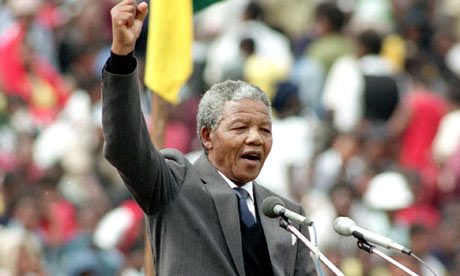-- By Tom Phillips
South Africa
Mandela’s dream of full democracy and justice inSouth Africa
-- Copyright 2013 by Tom Phillips
In 1990, when the South African government released Nelson
Mandela from prison, the whole country was eager to see the man who had led the
African National Congress and the anti-apartheid movement from behind bars for
nearly 28 years. But no one knew what he
looked like. Black South Africans wore
T-shirts with a picture of Mandela when he was a young boxing champion,
with a full face and cannonball shoulders.
When he finally appeared a few days later at a packed soccer
stadium in Soweto
At least 85 thousand people were in the stadium. They had streamed from all around Johannesburg
Finally, Mandela appeared.
A convoy of vehicles drove onto the track around the soccer field, and
he emerged, waving. He looked nothing
like his picture, but it was him, slim and erect, calm and disciplined, ready
to take up his role as leader of South Africa
Apartheid was still in force; housing, education,
employment, health care all divided by race, with blacks getting the worst of
everything. In freeing Mandela, the government had
committed itself to dismantling the racist system, but it had to be held to its
word. In this first speech following
his release, Mandela laid out the terms of what would be a near-miraculous
peaceful transition from oppression to majority rule.
Over years of negotiation in prison, Mandela had refused to
renounce violence, and he repeated that refusal to the crowd in Soweto South
Afrrica without apartheid would be a “better home for all.”
Mandela spoke for about half an hour, but most in the crowd
were too excited to listen carefully.
They applauded his calls for decent housing, better education and a
living wage for black workers. But there
was a buzz of conversation in the stadium throughout. A CBS News correspondent on the scene told me
he thought the speech was a flop. I
disagreed.
At the end, the entire crowd stood up and sang the
then-unofficial national anthem of South Africa
(After the speech, I stood around waiting nervously until someone from CBS came upstairs to reunite
me with the team. While waiting
I must have looked so anxious that an ANC Marshal offered a popsicle to cheer
me up.)
Mandela made his position unmistakable the next day, when we
interviewed him at his home in Soweto
Everyone knew there was a bottomless pit of grievances that cried out for revenge in South Africa Africa a
sorely needed example of a democratic transition.
Mandela’s dream of full democracy and justice in
-- Copyright 2013 by Tom Phillips


No comments:
Post a Comment